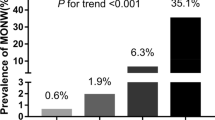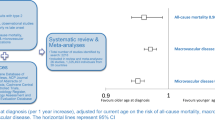Abstract
Previous studies have found that fat mass and lean body mass may act differently on the prognosis in patients type 2 diabetes mellitus (T2DM). However, the change of fat mass and lean body mass on prognosis in T2DM patients has not yet been investigated. We performed a Post hoc analysis of data from the Action to Control Cardiovascular Risk in Diabetes (ACCORD) study. Cox proportional hazards models were used to study the relationship between tertiles of the change trend in lean body mass index (LBMI, kg/m2/year) or fat mass index (FMI, kg/m2/year) and major cardiovascular adverse events (MACEs) and all cause mortality. Nine thousand, one hundred seventy-six T2DM patients with a mean follow-up of 9.52 ± 1.89 years were included in our study. The mean change in FMI per year was 0.10 ± 0.48 kg/m2. The mean change in LBMI per year was 0.05 ± 0.38 kg/m2. Normal weight patients had highest FMI/LBMI change; severely obese patients had lowest FMI/LBMI change. A U-shaped relationship was found between the change in FMI/LBMI and all cause mortality. A flat U-shaped relationship was also noted between the change in FMI or LBMI and MACEs. Compared with the second tertile, the first and third tertiles of the change in FMI (HR: 1.18, 95% CI 1.03–1.36; HR: 1.34, 95% CI 1.16–1.54, respectively)/LBMI (HR: 1.24, 95% CI 1.08–1.43; HR: 1.30, 95% CI 1.12–1.50, respectively) had higher all cause mortality; the third tertile of the change in FMI/LBMI showed a marginal increase of MACEs (HR: 1.15, 95% CI 1.01–1.32; HR: 1.17, 95% CI 1.02–1.33, respectively); sensitivity analysis and subgroup analysis showed these associations were not robust. Both lower and larger change in FMI or LBMI are associated with increased all cause mortality compared with the median change among patients with T2DM. Further study is needed to determine whether increased FMI or LBMI increases the risk of MACEs.
Trial registration: clinicaltrials.gov., No. NCT00000620.



Similar content being viewed by others
Data availability
Data are available from the Biologic Specimen and Data Repository Information Coordinating Center (BioLINCC).
Abbreviations
- T2DM:
-
Type 2 diabetes mellitus
- BMI:
-
Body mass index
- ACCORD:
-
The action to control cardiovascular risk in diabetes
- CVD:
-
Cardiovascular disease
- SEE:
-
Standard error of estimate
- LBMI:
-
Lean body mass index
- FMI:
-
Fat body mass index
- MACEs:
-
Major adverse cardiovascular events
- MI:
-
Myocardial infarction
References
Lavie CJ, De Schutter A, Parto P et al (2016) Obesity and prevalence of cardiovascular diseases and prognosis-the obesity paradox updated. Prog Cardiovasc Dis 58:537–547
Lissner L, Odell PM, D’Agostino RB et al (1991) Variability of body weight and health outcomes in the Framingham population. N Engl J Med 324:1839–1844
Stähli BE, Gebhard C, Gick M et al (2016) Impact of body mass index on long-term mortality in women and men undergoing percutaneous coronary intervention for chronic total occlusion. Int J Cardiol 224:305–309
Lee DH, Keum N, Hu FB et al (2018) Comparison of the association of predicted fat mass, body mass index, and other obesity indicators with type 2 diabetes risk: two large prospective studies in US men and women. Eur J Epidemiol 33:1113–1123
Xing Z, Tang L, Chen J et al (2019) Association of predicted lean body mass and fat mass with cardiovascular events in patients with type 2 diabetes mellitus. CMAJ 191:E1042–E1048
Xing Z, Pei J, Huang J et al (2019) Weight change is associated with increased all-cause mortality and non-cardiac mortality among patients with type 2 diabetes mellitus. Endocrine 64:82–89
Choi S, Kim K, Kim SM et al (2018) Association of obesity or weight change with coronary heart disease among young adults in South Korea. JAMA Intern Med 178:1060–1068
Volpato S, Bianchi L, Lauretani F et al (2012) Role of muscle mass and muscle quality in the association between diabetes and gait speed. Diabetes Care 35:1672–1679
Gerstein HC, Riddle MC, Kendall DM et al (2007) Glycemia treatment strategies in the action to control cardiovascular risk in diabetes (ACCORD) trial. Am J Cardiol 99:34i–43i
Gerstein HC, Miller ME, Action to Control Cardiovascular Risk in Diabetes Study Group et al (2008) Effects of intensive glucose lowering in type 2 diabetes. N Engl J Med 358:2545–2559
Gerstein HC, Miller ME, ACCORD StudyGroup et al (2011) Long-term effects of intensive glucose lowering on cardiovascular outcomes. N Engl J Med 364:818–828
Lee DH, Keum N, Hu FB et al (2017) Development and validation of anthropometric prediction equations for lean body mass, fat mass and percent fat in adults using the National Health and Nutrition Examination Survey (NHANES) 1999–2006. Br J Nutr 118:858–866
Jeong SM, Lee DH, Giovannucci EL (2019) Predicted lean body mass, fat mass and risk of lung cancer: prospective US cohort study. Eur J Epidemiol 34(12):1151–1160
Lee DH, Keum N, Hu FB et al (2018) Predicted lean body mass, fat mass, and all cause and cause specific mortality in men: prospective US cohort study. BMJ 362:k2575
Bowman TS, Kurth T, Sesso HD, Manson JE, Gaziano JM (2007) Eight-year change in body mass index and subsequent risk of cardiovascular disease among healthy non-smoking men. Prev Med 45:436–441
Sheehan TJ, DuBrava S, DeChello LM, Fang Z (2003) Rates of weight change for black and white Americans over a twenty year period. Int J Obes Relat Metab Disord 27:498–504
Chen C, Ye Y, Zhang Y, Pan XF, Pan A (2019) Weight change across adulthood in relation to all cause and cause specific mortality: prospective cohort study. BMJ 367:l5584
Karahalios A, English DR, Simpson JA (2017) Change in body size and mortality: a systematic review and meta-analysis. Int J Epidemiol 46:526–546
Benderly M, Boyko V, Goldbourt U (2010) Relation of body mass index to mortality among men with coronary heart disease. Am J Cardiol 106:297–304
Xing Z, Pei J, Huang J, Peng X, Chen P, Hu X (2018) Relationship of obesity to adverse events among patients with mean 10-year history of type 2 diabetes mellitus: results of the ACCORD study. J Am Heart Assoc 7(22):010512
Acknowledgements
Xiangping Chai and Zhenhua Xing were involved in the conception and design, analysis and interpretation of the data; the drafting of the paper, revising it critically for intellectual content; and the final approval of the version to be published; and that all authors agree to be accountable for all aspects of the work.
Funding
This work was supported in part by National Science Foundation of China project 82000298 to Dr. Xing. They did no role in preparing this article.
Author information
Authors and Affiliations
Corresponding author
Ethics declarations
Consent for publication
All listed authors have approved the manuscript and agreed to its publication.
Conflict of interest
The authors declare that they have no conflict of interest.
Statements on human and animal rights
This article does not contain any studies with human participants or animals performed by any of the authors.
Informed consent
None.
Additional information
Publisher's Note
Springer Nature remains neutral with regard to jurisdictional claims in published maps and institutional affiliations.
Supplementary Information
Below is the link to the electronic supplementary material.
Rights and permissions
About this article
Cite this article
Xing, Z., Chai, X. Changes in fat mass and lean body mass and outcomes in type 2 diabetes mellitus. Intern Emerg Med 17, 1073–1080 (2022). https://doi.org/10.1007/s11739-021-02916-4
Received:
Accepted:
Published:
Issue Date:
DOI: https://doi.org/10.1007/s11739-021-02916-4




